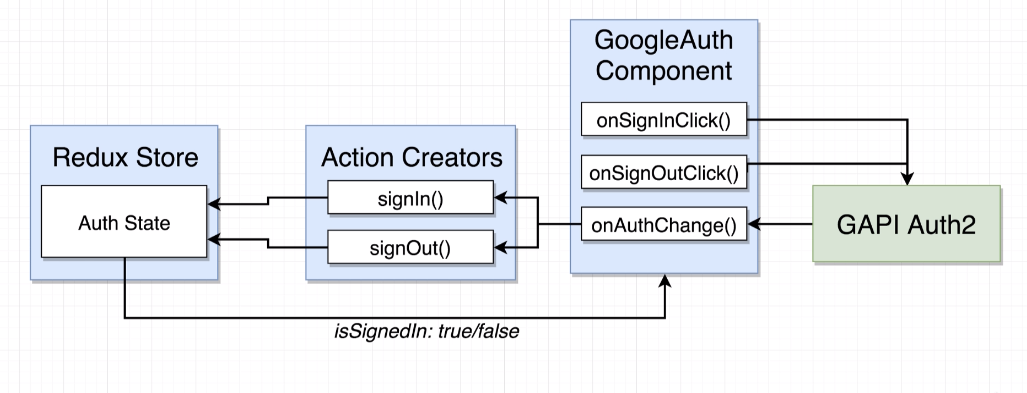React: Google Auth
Google Authentication with React
You need to add <script src="https://apis.google.com/js/api.js"></script> to index.htm.
Then you need to create Oauth Credentials at http://console.developers.google.com. Click on projects dropdown in the top, then click on New Project.
Enter project name and click create. After few seconds you should see your project in projects dropdown. Select your new project and choose Credentials -> Oauth consent screen and enter just application name.
After that go to Credentials -> Credentials -> Create Credentials -> OAuth Client Id -> Web Application. Add http://localhost:3000 to Authorized JavaScript Origins and click Create. You should then see your client ID.
src/components/GoogleAuth.js
import React from 'react';
class GoogleAuth extends React.Component {
state = { isSignedIn: null};
componentDidMount() {
window.gapi.load('client:auth2', () => {
window.gapi.client.init({
clientId: YOUR_CLIENT_ID,
scope: 'email'
}).then(() => {
this.auth = window.gapi.auth2.getAuthInstance();
this.setState({ isSignedIn: this.auth.isSignedIn.get() });
this.auth.isSignedIn.listen(this.onAuthChange);
});
});
}
onAuthChange = () => {
this.setState({ isSignedIn: this.auth.isSignedIn.get() });
};
onSignInClick = () => {
this.auth.signIn();
}
onSignOutClick = () => {
this.auth.signOut();
}
renderAuthButton() {
if (this.state.isSignedIn === null) {
return null;
} else if (this.state.isSignedIn) {
return (
<button onClick={this.onSignOutClick} className="ui red google button">
<i className="google icon" />
Sign Out
</button>
)
} else {
return (
<button onClick={this.onSignInClick} className="ui red google button">
<i className="google icon" />
Sign In
</button>
)
}
}
render() {
return (
<div>{this.renderAuthButton()}</div>
);
}
}
export default GoogleAuth;Google Authentication with React and Redux
Without Redux, authentication state is available only in GoogleAuth component, so for other components can be complicated to reach it. We will update it to use Redux, so it will be available in props. We will also catch user google id, so we can then identify which use is currently logged in.

scr/actions/types.js
export const SIGN_IN = 'SIGN_IN';
export const SIGN_OUT = 'SIGN_OUT';scr/actions/index.js
import { SIGN_IN, SIGN_OUT } from './types';
export const signIn = (userId) => {
return {
type: SIGN_IN,
payload: userId
}
}
export const signOut = () => {
return {
type: SIGN_OUT
}
}scr/reducers/authReducer.js
import { SIGN_IN, SIGN_OUT } from '../actions/types';
const INITIAL_STATE = {
isSignedIn: null,
userId: null
};
export default(state = INITIAL_STATE, action) => {
switch (action.type) {
case SIGN_IN:
return { ...state, isSignedIn: true, userId: action.payload };
case SIGN_OUT:
return { ...state, isSignedIn: false, userId: null };
default:
return state;
}
};scr/reducers/index.js
import { combineReducers } from 'redux';
import authReducer from './authReducer';
export default combineReducers({
auth: authReducer
});src/components/GoogleAuth.js
import React from 'react';
import { connect } from 'react-redux';
import { signIn, signOut } from '../actions';
class GoogleAuth extends React.Component {
componentDidMount() {
window.gapi.load('client:auth2', () => {
window.gapi.client.init({
clientId: YOUR_CLIENT_ID,
scope: 'email'
}).then(() => {
this.auth = window.gapi.auth2.getAuthInstance();
this.onAuthChange(this.auth.isSignedIn.get());
this.auth.isSignedIn.listen(this.onAuthChange);
});
});
}
onAuthChange = (isSignedIn) => {
if (isSignedIn) {
this.props.signIn(this.auth.currentUser.get().getId());
} else {
this.props.signOut();
}
};
onSignIn = () => {
this.auth.signIn();
}
onSignOut = () => {
this.auth.signOut();
}
renderAuthButton() {
if (this.props.isSignedIn === null) {
return null;
} else if (this.props.isSignedIn) {
return (
<button onClick={this.onSignOut} className="ui red google button">
<i className="google icon" />
Sign Out
</button>
)
} else {
return (
<button onClick={this.onSignIn} className="ui red google button">
<i className="google icon" />
Sign In
</button>
)
}
}
render() {
return (
<div>{this.renderAuthButton()}</div>
);
}
}
const mapStateToProps = (state) => {
return {
isSignedIn: state.auth.isSignedIn
};
}
export default connect(
mapStateToProps,
{ signIn, signOut })
(GoogleAuth);scr/index.js
import React from 'react';
import ReactDOM from 'react-dom';
import { Provider } from 'react-redux';
import { createStore } from 'redux';
import App from './components/App';
import reducers from './reducers';
const store = createStore(reducers);
ReactDOM.render(
<Provider store={store}>
<App />
</Provider>,
document.querySelector('#root')
);